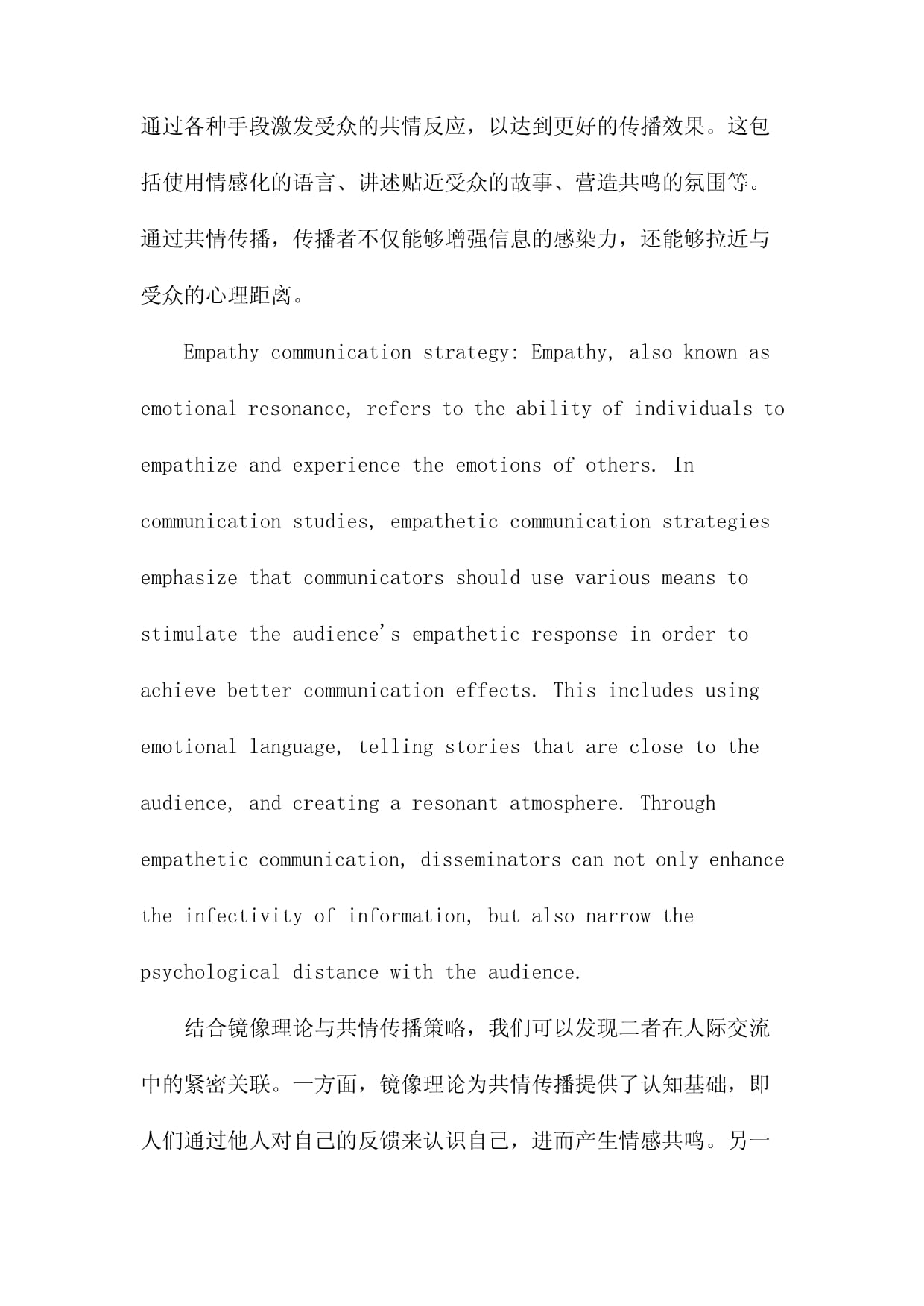




版权说明:本文档由用户提供并上传,收益归属内容提供方,若内容存在侵权,请进行举报或认领
文档简介
镜像理论视阈下自我与他者的共情传播策略以《你好,李焕英》为例一、本文概述Overviewofthisarticle本文旨在从镜像理论的视阈出发,深入剖析电影《大家好,李焕英》中自我与他者之间的共情传播策略。镜像理论,源自法国社会学家拉康的镜像阶段理论,主张个体通过他人对自己的反映来形成自我认知。电影《大家好,李焕英》以其独特的叙事手法和深刻的情感表达,成功构建了一个关于母爱、自我认知以及共情传播的镜像世界。本文将首先介绍镜像理论的基本概念和核心观点,然后分析电影如何通过影像、情节和角色塑造等手段,实现自我与他者之间的共情传播,最后探讨这种共情传播策略对于影片艺术效果和观众情感共鸣的影响。通过这一分析,我们不仅能够深入理解电影《大家好,李焕英》的艺术魅力,还能够对镜像理论在共情传播中的应用有更深入的认识。Thisarticleaimstoanalyzetheempathycommunicationstrategybetweentheselfandtheotherinthemovie"Helloeveryone,LiHuanying"fromtheperspectiveofmirrortheory.Mirrortheory,originatingfromthemirrorstagetheoryofFrenchsociologistLacan,advocatesthatindividualsformself-awarenessthroughthereflectionofothersonthemselves.Themovie"Helloeveryone,LiHuanying"successfullyconstructsamirroredworldaboutmaternallove,self-awareness,andempatheticcommunicationwithitsuniquenarrativetechniquesandprofoundemotionalexpression.Thisarticlewillfirstintroducethebasicconceptsandcoreviewpointsofmirrortheory,thenanalyzehowmoviesachieveempatheticcommunicationbetweenthemselvesandothersthroughmeanssuchasimagery,plot,andcharactershaping.Finally,itwillexploretheimpactofthisempatheticcommunicationstrategyontheartisticeffectoffilmsandtheemotionalresonanceofaudiences.Throughthisanalysis,wecannotonlygainadeeperunderstandingoftheartisticcharmofthemovie"Helloeveryone,LiHuanying",butalsogainadeeperunderstandingoftheapplicationofmirrortheoryinempathycommunication.二、镜像理论与共情传播策略概述OverviewofMirrorTheoryandEmpathyCommunicationStrategies镜像理论:镜像理论最初由法国精神分析学家雅克·拉康提出,他认为,婴儿在镜中认识到的自己的形象,并非真实存在的自我,而是他人眼中的自己。这一理论强调了他人对个体自我认知的塑造作用。在社交传播中,人们往往会通过他人的反馈来认识自己,调整自己的行为和态度。镜像理论为理解人际交流中的自我塑造提供了独特的视角。MirrorTheory:MirrorTheorywasoriginallyproposedbyFrenchpsychoanalystJacquesLacan,whobelievedthattheimageofoneselfperceivedbyababyinamirrorisnottheactualself,buttheselfintheeyesofothers.Thistheoryemphasizestheroleofothersinshapinganindividual'sself-awareness.Insocialcommunication,peopleoftengettoknowthemselvesandadjusttheirbehaviorandattitudesthroughfeedbackfromothers.Themirrortheoryprovidesauniqueperspectiveforunderstandingselfshapingininterpersonalcommunication.共情传播策略:共情,即情感共鸣,是指个体能够设身处地地理解和体验他人的情感。在传播学中,共情传播策略强调传播者要通过各种手段激发受众的共情反应,以达到更好的传播效果。这包括使用情感化的语言、讲述贴近受众的故事、营造共鸣的氛围等。通过共情传播,传播者不仅能够增强信息的感染力,还能够拉近与受众的心理距离。Empathycommunicationstrategy:Empathy,alsoknownasemotionalresonance,referstotheabilityofindividualstoempathizeandexperiencetheemotionsofothers.Incommunicationstudies,empatheticcommunicationstrategiesemphasizethatcommunicatorsshouldusevariousmeanstostimulatetheaudience'sempatheticresponseinordertoachievebettercommunicationeffects.Thisincludesusingemotionallanguage,tellingstoriesthatareclosetotheaudience,andcreatingaresonantatmosphere.Throughempatheticcommunication,disseminatorscannotonlyenhancetheinfectivityofinformation,butalsonarrowthepsychologicaldistancewiththeaudience.结合镜像理论与共情传播策略,我们可以发现二者在人际交流中的紧密关联。一方面,镜像理论为共情传播提供了认知基础,即人们通过他人对自己的反馈来认识自己,进而产生情感共鸣。另一方面,共情传播策略则能够强化这种认知和情感的联系,使人们在交流中更加深入地理解和体验彼此的情感状态。Bycombiningmirrortheorywithempathycommunicationstrategies,wecandiscoveraclosecorrelationbetweenthetwoininterpersonalcommunication.Ontheonehand,themirrortheoryprovidesacognitivebasisforempatheticcommunication,wherepeoplerecognizethemselvesthroughfeedbackfromothers,therebygeneratingemotionalresonance.Ontheotherhand,empatheticcommunicationstrategiescanstrengthentheconnectionbetweencognitionandemotion,enablingpeopletounderstandandexperienceeachother'semotionalstatesmoredeeplyincommunication.以电影《大家好,李焕英》为例,该影片通过讲述母女之间的情感故事,成功地运用了共情传播策略。影片中细腻的情感刻画和贴近生活的情节设置,引发了观众对自己与母亲关系的共鸣和思考。观众在观影过程中也通过镜像效应,更加深刻地认识到了自己在母女关系中的角色和定位。这种对自我和他者情感的共鸣与认知,不仅增强了影片的艺术感染力,也提升了其传播效果。Takingthemovie"Helloeveryone,LiHuanying"asanexample,thefilmsuccessfullyemploysempathycommunicationstrategybytellingtheemotionalstorybetweenmotheranddaughter.Thedelicateemotionalportrayalandclosetolifeplotsettingsinthefilmhavetriggeredresonanceandreflectionamongtheaudienceontheirrelationshipwiththeirmother.Duringtheviewingprocess,theaudiencealsogainedadeeperunderstandingoftheirroleandpositioninginthemotherdaughterrelationshipthroughthemirroreffect.Thisresonanceandrecognitionofemotionstowardsoneselfandothersnotonlyenhancestheartisticappealofthefilm,butalsoenhancesitsdisseminationeffect.三、电影《你好,李焕英》案例分析Caseanalysisofthemovie"Hello,LiHuanying"电影《大家好,李焕英》是一部以母女关系为核心的情感剧,其成功在很大程度上源于其对自我与他者共情传播策略的精准把握。从镜像理论的视阈下看,这部电影通过一系列精心构建的情节和角色塑造,实现了观众对自我与他者的深度共情。Themovie"Helloeveryone,LiHuanying"isanemotionaldramacenteredonthemotherdaughterrelationship,anditssuccesslargelystemsfromitsprecisegraspofthestrategyofempatheticcommunicationbetweenoneselfandothers.Fromtheperspectiveofmirrortheory,thismovieachievesdeepempathybetweentheaudienceandthemselvesthroughaseriesofcarefullyconstructedplotsandcharactershaping.影片中,主角贾晓玲意外穿越回1981年,与正值青春的母亲李焕英相遇。这种时空交错的设定,使得贾晓玲有机会从外部观察并参与到母亲的生活中,从而实现了自我与他者的双重镜像体验。在这一过程中,贾晓玲不仅看到了母亲的青春岁月,更深入地理解了母亲的付出与牺牲,进而引发了强烈的情感共鸣。Inthefilm,theprotagonistJiaXiaolingunexpectedlytravelsbackto1981andmeetsheryouthfulmotherLiHuanying.ThisintertwinedsettingoftimeandspacegaveJiaXiaolingtheopportunitytoobserveandparticipateinhermother'slifefromtheoutside,thusachievingadualmirrorexperienceofherselfandothers.Duringthisprocess,JiaXiaolingnotonlywitnessedhermother'syouth,butalsogainedadeeperunderstandingofhereffortsandsacrifices,whichsparkedastrongemotionalresonance.电影中,贾晓玲与李焕英之间的互动充满了细腻的情感表达。无论是贾晓玲为了让母亲开心而付出的种种努力,还是李焕英对贾晓玲的默默关怀与支持,都让观众感受到了母女之间深厚的情感纽带。这种情感的传递,正是基于镜像理论中的共情传播策略,即通过展示角色之间的情感互动,引发观众对自我与他者的情感共鸣。Inthemovie,theinteractionbetweenJiaXiaolingandLiHuanyingisfullofdelicateemotionalexpressions.WhetheritisthevariouseffortsmadebyJiaXiaolingtomakehermotherhappy,orLiHuanying'ssilentcareandsupportforJiaXiaoling,theaudiencehasfelttheprofoundemotionalbondbetweenmotheranddaughter.Thetransmissionofthisemotionisbasedontheempathycommunicationstrategyinthemirrortheory,whichinvolvesshowcasingtheemotionalinteractionbetweencharactersandtriggeringemotionalresonancebetweentheaudienceandthemselvesandothers.《大家好,李焕英》还通过一些细节处理来强化观众的共情体验。例如,电影中多次出现母女二人相视而笑的场景,这种温馨的画面不仅让观众感受到了母女之间的深厚情感,也激发了观众对自我亲情关系的回忆与思考。这种情感共鸣的产生,正是基于镜像理论中自我与他者之间的情感联系和互动。Helloeveryone,LiHuanyingalsoenhancestheaudience'sempathyexperiencethroughsomedetailedhandling.Forexample,inmovies,therearemultiplesceneswheremotheranddaughtersmileateachother.Thiswarmscenenotonlyallowstheaudiencetofeeltheprofoundemotionsbetweenmotheranddaughter,butalsostimulatestheirmemoriesandreflectionsontheirownfamilyrelationship.Theemergenceofthisemotionalresonanceisbasedontheemotionalconnectionandinteractionbetweentheselfandtheotherinthemirrortheory.《大家好,李焕英》通过精心构建的情节和角色塑造,以及细腻的情感表达和细节处理,成功地实现了观众对自我与他者的深度共情。这不仅让观众在观影过程中获得了强烈的情感体验,也让观众对自我与他者之间的关系有了更深刻的认识和思考。这种共情传播策略的成功运用,也是该电影能够赢得观众喜爱和口碑的重要原因之一。Helloeveryone,LiHuanyingsuccessfullyachievesdeepempathybetweentheaudienceandthemselvesthroughcarefullyconstructedplotandcharactershaping,aswellasdelicateemotionalexpressionanddetailhandling.Thisnotonlyprovidestheaudiencewithastrongemotionalexperienceduringtheviewingprocess,butalsoenablesthemtohaveadeeperunderstandingandreflectionontherelationshipbetweenthemselvesandothers.Thesuccessfulapplicationofthisempathycommunicationstrategyisalsooneoftheimportantreasonswhythemoviecanwintheloveandreputationoftheaudience.四、自我与他者共情传播策略在《你好,李焕英》中的具体体现Thespecificembodimentofthestrategyofempatheticcommunicationbetweenoneselfandothersin"Hello,LiHuanying"在贾玲执导的电影《大家好,李焕英》中,自我与他者共情传播策略得到了深刻的体现。影片通过巧妙的叙事手法和真挚的情感表达,成功地构建了自我与他者之间的情感桥梁,让观众在感动中体会到了共情的力量。Inthemovie"Helloeveryone,LiHuanying"directedbyJiaLing,thestrategyofempatheticcommunicationbetweenoneselfandothersisdeeplyreflected.Thefilmsuccessfullyconstructsanemotionalbridgebetweenoneselfandothersthroughclevernarrativetechniquesandsincereemotionalexpression,allowingtheaudiencetoexperiencethepowerofempathyintheiremotions.影片中的主角贾晓玲意外穿越回上世纪80年代,与正值青春的母亲李焕英相遇。这一设定打破了时空界限,使得主角有机会从“他者”的视角重新审视自己的母亲,从而更深入地理解母亲的内心世界和人生选择。在这一过程中,贾晓玲不断地调整自我认知,试图与李焕英产生共情,这种努力最终促成了母女之间深层次的情感交流。TheprotagonistJiaXiaolinginthefilmunexpectedlytravelsbacktothe1980sandmeetsheryouthfulmotherLiHuanying.Thissettingbreakstheboundariesoftimeandspace,givingtheprotagonisttheopportunitytore-examinetheirmotherfromtheperspectiveof"others",therebygainingadeeperunderstandingofherinnerworldandlifechoices.Duringthisprocess,JiaXiaolingconstantlyadjustedherself-awarenessandattemptedtoempathizewithLiHuanying,whichultimatelyledtodeepemotionalcommunicationbetweenmotheranddaughter.影片通过一系列细腻的情感刻画和情节安排,展现了自我与他者共情传播策略的多个层面。例如,贾晓玲在穿越后努力融入80年代的生活,体验母亲的青春岁月,这一过程中她不仅学习了母亲的生活习惯,更深入地理解了母亲的喜怒哀乐。这种情感上的投入和体验使得贾晓玲能够站在母亲的角度思考问题,从而产生了强烈的共情。Thefilmshowcasesmultiplelevelsofempathycommunicationstrategiesbetweenoneselfandothersthroughaseriesofdelicateemotionaldepictionsandplotarrangements.Forexample,JiaXiaolingworkedhardtointegrateintothelifeofthe1980saftertraveling,experiencinghermother'syouth.Duringthisprocess,shenotonlylearnedabouthermother'slifestylehabits,butalsogainedadeeperunderstandingofhermother'sjoysandsorrows.ThisemotionalinvestmentandexperienceenabledJiaXiaolingtothinkfromhermother'sperspective,thusgeneratingstrongempathy.影片还通过一些具体的情节来强化共情传播的效果。比如,贾晓玲在得知母亲的真实愿望后,决定帮助母亲追求幸福,这一过程中她不断地调整自己的行为和态度,以符合母亲的期望。这种努力不仅让母亲感受到了女儿的关爱和理解,也让观众深刻地体会到了自我与他者之间共情传播的重要性。Thefilmalsoenhancestheeffectofempatheticcommunicationthroughspecificplots.Forexample,afterlearningabouthermother'struewishes,JiaXiaolingdecidedtohelpherpursuehappiness.Duringthisprocess,sheconstantlyadjustedherbehaviorandattitudetomeethermother'sexpectations.Thiseffortnotonlymadethemotherfeelherdaughter'sloveandunderstanding,butalsomadetheaudiencedeeplyappreciatetheimportanceofempatheticcommunicationbetweenthemselvesandothers.《大家好,李焕英》通过自我与他者共情传播策略的成功运用,让观众在观影过程中感受到了深刻的情感共鸣。这种情感共鸣不仅增强了影片的艺术感染力,也让观众在思考自我与他人关系时获得了新的启示。Helloeveryone,LiHuanyingsuccessfullyutilizedthestrategyofempatheticcommunicationbetweenoneselfandothers,allowingtheaudiencetoexperienceprofoundemotionalresonanceduringtheviewingprocess.Thisemotionalresonancenotonlyenhancestheartisticappealofthefilm,butalsoprovidesnewinsightsfortheaudiencewhenthinkingabouttheirownrelationshipswithothers.五、结论与启示Conclusionandinspiration通过对《大家好,李焕英》的深入分析,我们可以清晰地看到镜像理论在自我与他者共情传播中的重要作用。这部电影成功地运用镜像反射机制,构建了一个真实而又触动人心的故事,让观众在观影过程中体验到了深刻的共情。Throughanin-depthanalysisof"Helloeveryone,LiHuanying",wecanclearlyseetheimportantroleofmirrortheoryinthecommunicationofempathybetweenoneselfandothers.Thismoviesuccessfullyutilizesthemirrorreflectionmechanismtoconstructarealandtouchingstory,allowingtheaudiencetoexperienceprofoundempathyduringtheviewingprocess.电影通过精准的人物塑造和情节设置,让观众在主人公贾晓玲的视角中看到了自己,感受到了她内心的挣扎与成长。这种自我认知的过程不仅增强了观众的情感投入,也让他们更加深入地理解了主人公的动机和行为。Themovie,throughprecisecharacterportrayalandplotsetting,allowstheaudiencetoseethemselvesfromtheperspectiveoftheprotagonistJiaXiaolingandfeelherinnerstruggleandgrowth.Thisself-awarenessprocessnotonlyenhancestheaudience'semotionalengagement,butalsoallowsthemtohaveadeeperunderstandingoftheprotagonist'smotivationandbehavior.电影中的母亲形象李焕英,作为一个典型的他者角色,通过无私的奉献和深沉的爱意,触动了观众内心深处的情感共鸣。观众在感受到李焕英的母爱的同时,也反思了自己与他人之间的关系,重新审视了自己在社交互动中的位置。ThemothercharacterLiHuanyinginthemovie,asatypicalothercharacter,touchestheemotionalresonancedeepintheaudience'sheartsthroughselflessdedicationanddeeplove.WhilefeelingLiHuanying'smaternallove,theaudiencealsoreflectedontheirownrelationshipswithothersandreexaminedtheirpositioninsocialinteraction.电影通过艺术化的叙事手法,成功地构建了一个自我与他者共情传播的桥梁。这种共情传播策略不仅增强了电影的感染力和影响力,也让观众在观影过程中得到了深刻的情感体验和心灵洗礼。Throughartisticnarrativetechniques,movieshavesuccessfullyconstructedabridgeofempathyandcommunicationbetweenthemselvesandothers.Thisempathycommunicat
温馨提示
- 1. 本站所有资源如无特殊说明,都需要本地电脑安装OFFICE2007和PDF阅读器。图纸软件为CAD,CAXA,PROE,UG,SolidWorks等.压缩文件请下载最新的WinRAR软件解压。
- 2. 本站的文档不包含任何第三方提供的附件图纸等,如果需要附件,请联系上传者。文件的所有权益归上传用户所有。
- 3. 本站RAR压缩包中若带图纸,网页内容里面会有图纸预览,若没有图纸预览就没有图纸。
- 4. 未经权益所有人同意不得将文件中的内容挪作商业或盈利用途。
- 5. 人人文库网仅提供信息存储空间,仅对用户上传内容的表现方式做保护处理,对用户上传分享的文档内容本身不做任何修改或编辑,并不能对任何下载内容负责。
- 6. 下载文件中如有侵权或不适当内容,请与我们联系,我们立即纠正。
- 7. 本站不保证下载资源的准确性、安全性和完整性, 同时也不承担用户因使用这些下载资源对自己和他人造成任何形式的伤害或损失。
最新文档
- 的基本建设合同样书范文合集
- 2022年度江西省报检员之报检员资格考试全真模拟考试试卷A卷含答案
- 汽车抵押借款合同样本合集
- 2022年度江西省安全评价师职业资格能力提升试卷B卷附答案
- 私人房屋转让买卖协议合集
- 2024年中考数学考前押题密卷(重庆卷)(全解全析)
- 2023年海岛自动气象遥测系统资金需求报告
- 2023年三次采油采出液絮凝剂资金需求报告
- 2024年异戊橡项目投资申请报告
- 2024年湖南省长沙市麓山国际实验学校物理高一下期末监测模拟试题含解析
- 2022年09月北京人民艺术剧院面向2023年应届毕业生招考笔试题库含答案解析
- 专题:变异来源分析专题
- CPU卡一卡通系统建设方案
- 某系杆拱桥吊杆安装张拉施工
- 机场生态学智慧树知到答案章节测试2023年滨州学院
- 三级安全教育(班组级、部门级、公司级)考试题(附答案)
- GB/T 6745-2008船壳漆
- 如何办理人大建议和政协提案-做好人大建议政课件
- 小学语文人教四年级下册第四单元《狼王梦》导读
- 《服装设计基础》期末试题及答案
- 2023年娄底市中医院医护人员招聘笔试题库及答案解析

评论
0/150
提交评论